PEUGEOT 3008 2017 Manual Online
Manufacturer: PEUGEOT, Model Year: 2017, Model line: 3008, Model: PEUGEOT 3008 2017Pages: 566, PDF Size: 16.05 MB
Page 81 of 566
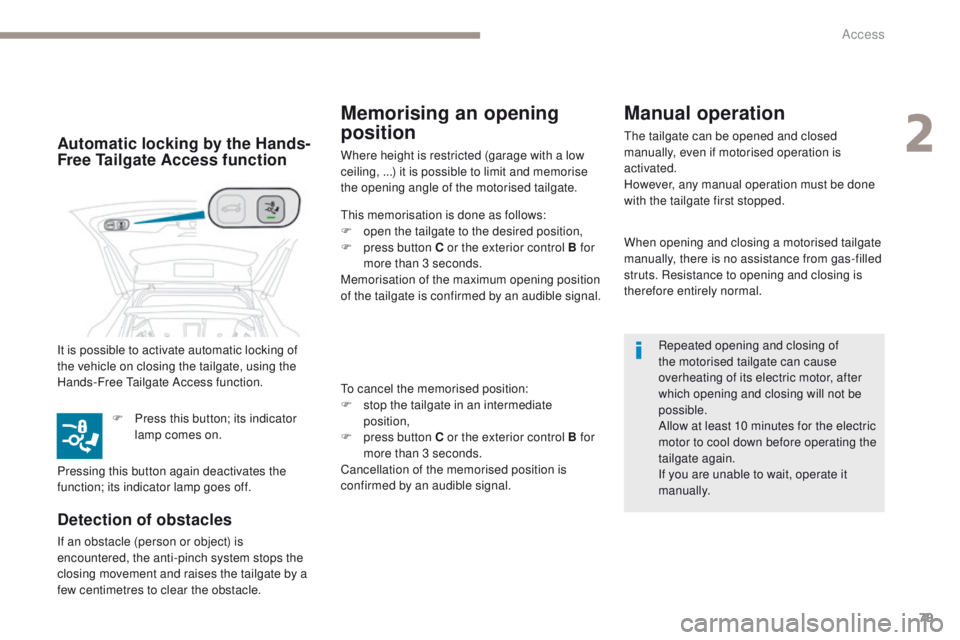
79
3008-2_en_Chap02_ouvertures_ed01-2016
When opening and closing a motorised tailgate
manually, there is no assistance from gas-filled
struts. Resistance to opening and closing is
therefore entirely normal.Repeated opening and closing of
the motorised tailgate can cause
overheating of its electric motor, after
which opening and closing will not be
possible.
Allow at least 10 minutes for the electric
motor to cool down before operating the
tailgate again.
If you are unable to wait, operate it
manually.
Detection of obstacles
If an obstacle (person or object) is
encountered, the anti-pinch system stops the
closing movement and raises the tailgate by a
few centimetres to clear the obstacle.
Memorising an opening
position
Where height is restricted (garage with a low
ceiling, ...) it is possible to limit and memorise
the opening angle of the motorised tailgate.
This memorisation is done as follows:
F
o
pen the tailgate to the desired position,
F
p
ress button C or the exterior control B for
more than 3 seconds.
Memorisation of the maximum opening position
of the tailgate is confirmed by an audible signal.
To cancel the memorised position:
F
s
top the tailgate in an intermediate
position,
F
p
ress button C or the exterior control B for
more than 3 seconds.
Cancellation of the memorised position is
confirmed by an audible signal.
Manual operation
The tailgate can be opened and closed
manually, even if motorised operation is
activated.
However, any manual operation must be done
with the tailgate first stopped.
It is possible to activate automatic locking of
the vehicle on closing the tailgate, using the
Hands-Free Tailgate Access function. F
P
ress this button; its indicator
lamp comes on.
Pressing this button again deactivates the
function; its indicator lamp goes off.Automatic locking by the Hands-
Free Tailgate Access function
2
Access
Page 82 of 566
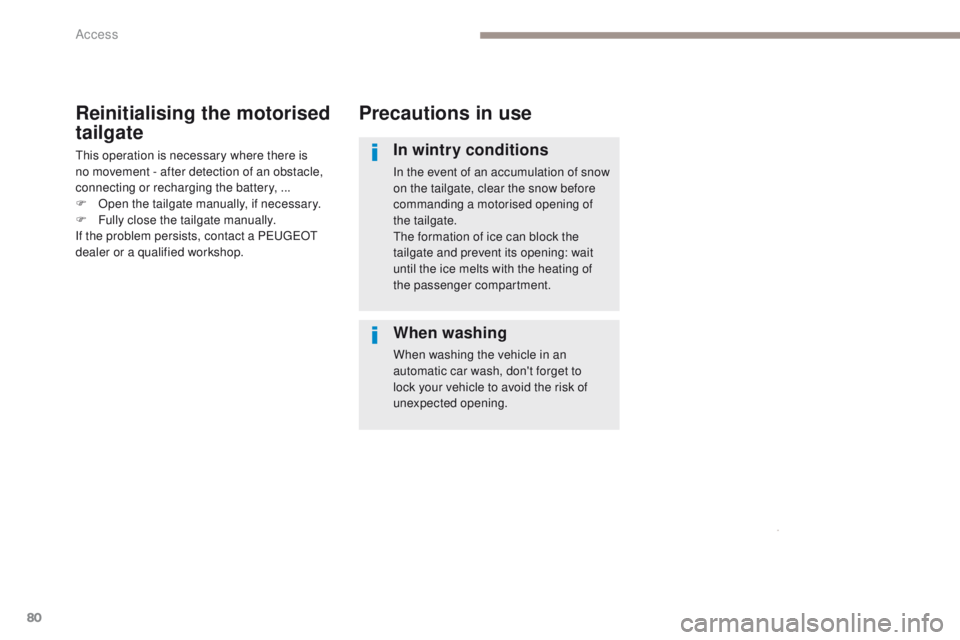
80
3008-2_en_Chap02_ouvertures_ed01-2016
Precautions in use
In wintry conditions
In the event of an accumulation of snow
on the tailgate, clear the snow before
commanding a motorised opening of
the tailgate.
The formation of ice can block the
tailgate and prevent its opening: wait
until the ice melts with the heating of
the passenger compartment.
When washing
When washing the vehicle in an
automatic car wash, don't forget to
lock your vehicle to avoid the risk of
unexpected opening.
Reinitialising the motorised
tailgate
This operation is necessary where there is
no movement - after detection of an obstacle,
connecting or recharging the battery, ...
F
O
pen the tailgate manually, if necessary.
F
F
ully close the tailgate manually.
If the problem persists, contact a PEUGEOT
dealer or a qualified workshop.
Access
Page 83 of 566
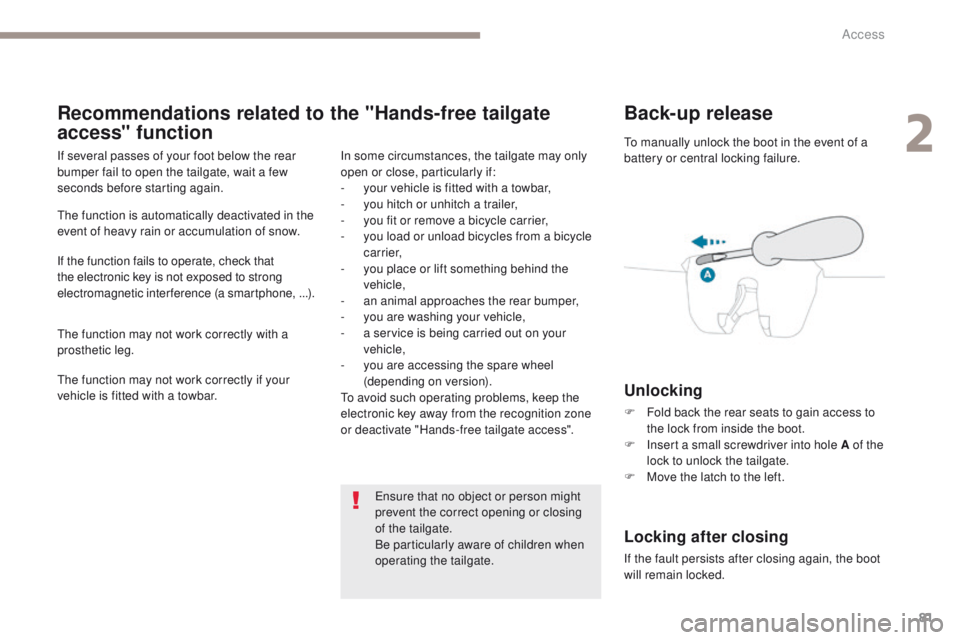
81
3008-2_en_Chap02_ouvertures_ed01-2016
Back-up release
Unlocking
F Fold back the rear seats to gain access to the lock from inside the boot.
F
I
nsert a small screwdriver into hole A of the
lock to unlock the tailgate.
F
M
ove the latch to the left.
Locking after closing
If the fault persists after closing again, the boot
will remain locked. To manually unlock the boot in the event of a
battery or central locking failure.
Recommendations related to the "Hands-free tailgate
access" function
If several passes of your foot below the rear
bumper fail to open the tailgate, wait a few
seconds before starting again.
The function is automatically deactivated in the
event of heavy rain or accumulation of snow.
If the function fails to operate, check that
the electronic key is not exposed to strong
electromagnetic interference (a smartphone, ...).
The function may not work correctly with a
prosthetic leg.
The function may not work correctly if your
vehicle is fitted with a towbar. In some circumstances, the tailgate may only
open or close, particularly if:
-
y
our vehicle is fitted with a towbar,
-
y
ou hitch or unhitch a trailer,
-
y
ou fit or remove a bicycle carrier,
-
y
ou load or unload bicycles from a bicycle
c a r r i e r,
-
y
ou place or lift something behind the
vehicle,
-
an
animal approaches the rear bumper,
-
y
ou are washing your vehicle,
-
a s
ervice is being carried out on your
vehicle,
-
y
ou are accessing the spare wheel
(depending on version).
To avoid such operating problems, keep the
electronic key away from the recognition zone
or deactivate "Hands-free tailgate access".
Ensure that no object or person might
prevent the correct opening or closing
of the tailgate.
Be particularly aware of children when
operating the tailgate.
2
Access
Page 84 of 566
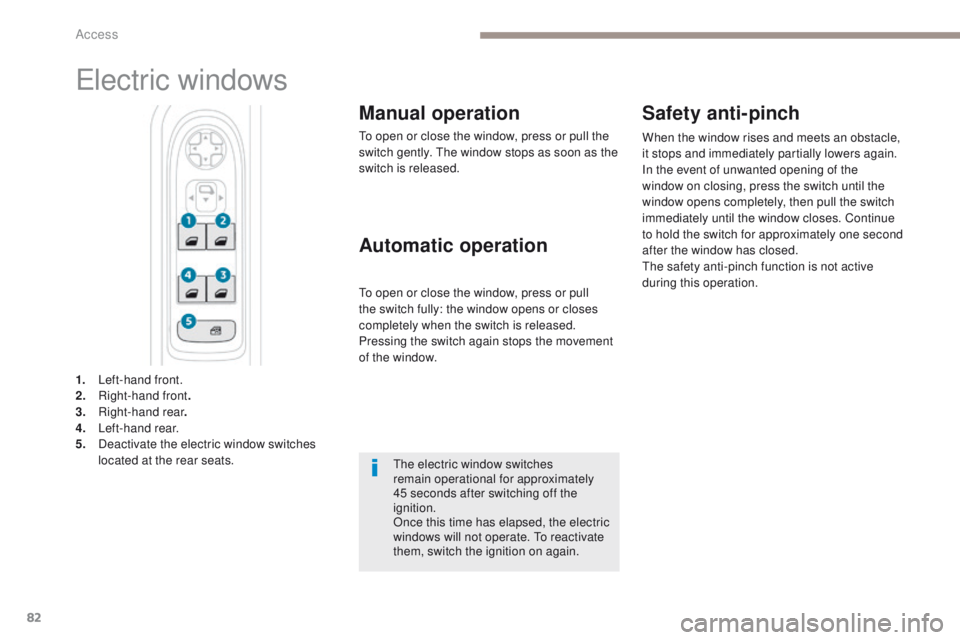
82
3008-2_en_Chap02_ouvertures_ed01-2016
Electric windows
Manual operation
To open or close the window, press or pull the
switch gently. The window stops as soon as the
switch is released.
1.
L
eft-hand front.
2.
R
ight-hand front .
3.
R
ight-hand rear .
4.
L
eft-hand rear.
5.
D
eactivate the electric window switches
located at the rear seats.
Automatic operation Safety anti-pinch
To open or close the window, press or pull
the switch fully: the window opens or closes
completely when the switch is released.
Pressing the switch again stops the movement
of the window. When the window rises and meets an obstacle,
it stops and immediately partially lowers again.
In the event of unwanted opening of the
window on closing, press the switch until the
window opens completely, then pull the switch
immediately until the window closes. Continue
to hold the switch for approximately one second
after the window has closed.
The safety anti-pinch function is not active
during this operation.
The electric window switches
remain operational for approximately
45
seconds after switching off the
ignition.
Once this time has elapsed, the electric
windows will not operate. To reactivate
them, switch the ignition on again.
Access
Page 85 of 566
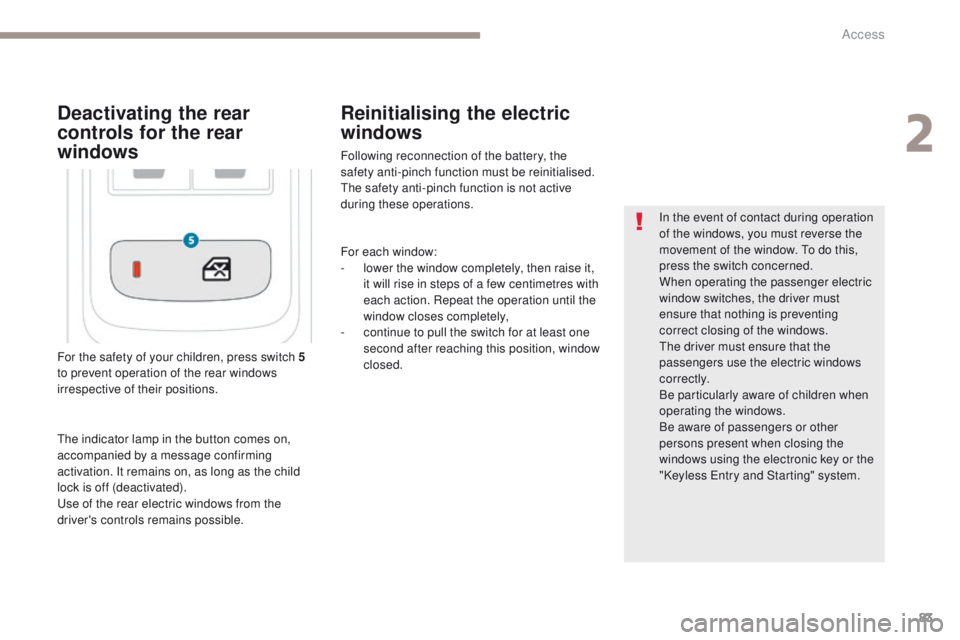
83
3008-2_en_Chap02_ouvertures_ed01-2016
For the safety of your children, press switch 5
t o prevent operation of the rear windows
irrespective of their positions. In the event of contact during operation
of the windows, you must reverse the
movement of the window. To do this,
press the switch concerned.
When operating the passenger electric
window switches, the driver must
ensure that nothing is preventing
correct closing of the windows.
The driver must ensure that the
passengers use the electric windows
c o r r e c t l y.
Be particularly aware of children when
operating the windows.
Be aware of passengers or other
persons present when closing the
windows using the electronic key or the
"Keyless Entry and Starting" system.
Deactivating the rear
controls for the rear
windows
The indicator lamp in the button comes on,
accompanied by a message confirming
activation. It remains on, as long as the child
lock is off (deactivated).
Use of the rear electric windows from the
driver's controls remains possible.
Reinitialising the electric
windows
Following reconnection of the battery, the
safety anti-pinch function must be reinitialised.
The safety anti-pinch function is not active
during these operations.
For each window:
-
l
ower the window completely, then raise it,
it will rise in steps of a few centimetres with
each action. Repeat the operation until the
window closes completely,
-
c
ontinue to pull the switch for at least one
second after reaching this position, window
closed.
2
Access
Page 86 of 566
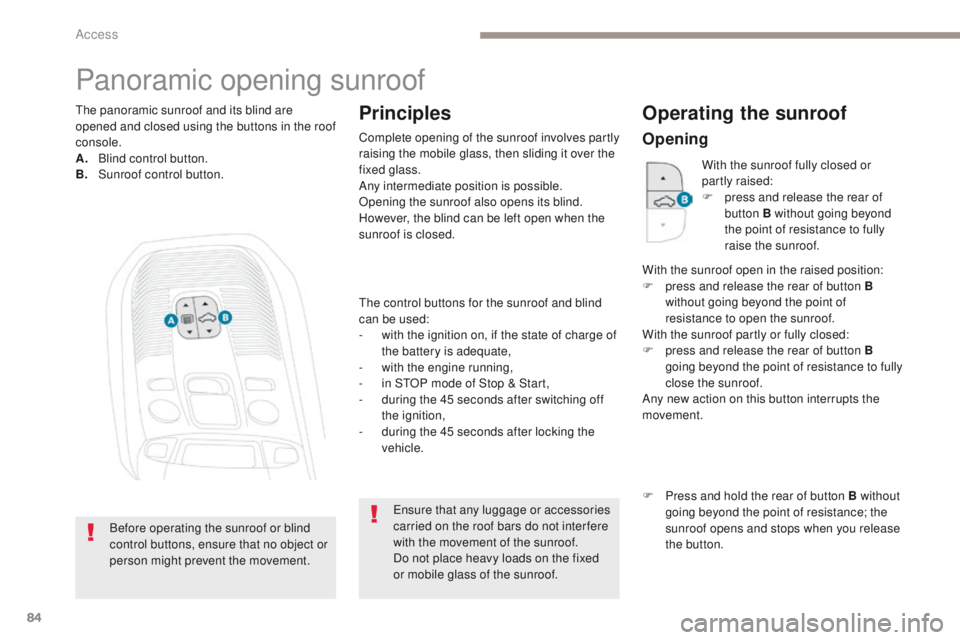
84
3008-2_en_Chap02_ouvertures_ed01-2016
Panoramic opening sunroof
The control buttons for the sunroof and blind
can be used:
-
w
ith the ignition on, if the state of charge of
the battery is adequate,
-
w
ith the engine running,
-
i
n STOP mode of Stop & Start,
-
d
uring the 45 seconds after switching off
the ignition,
-
d
uring the 45 seconds after locking the
vehicle.
Opening
The panoramic sunroof and its blind are
opened and closed using the buttons in the roof
console.
A.
B
lind control button.
B.
S
unroof control button.
Ensure that any luggage or accessories
carried on the roof bars do not inter fere
with the movement of the sunroof.
Do not place heavy loads on the fixed
or mobile glass of the sunroof.
Before operating the sunroof or blind
control buttons, ensure that no object or
person might prevent the movement.Principles
Complete opening of the sunroof involves partly
raising the mobile glass, then sliding it over the
fixed glass.
Any intermediate position is possible.
Opening the sunroof also opens its blind.
However, the blind can be left open when the
sunroof is closed. With the sunroof fully closed or
partly raised:
F
p
ress and release the rear of
button B without going beyond
the point of resistance to fully
raise the sunroof.
With the sunroof open in the raised position:
F
p
ress and release the rear of button B
without going beyond the point of
resistance to open the sunroof.
With the sunroof partly or fully closed:
F
p
ress and release the rear of button B
going beyond the point of resistance to fully
close the sunroof.
Any new action on this button interrupts the
movement.
Operating the sunroof
F Press and hold the rear of button B without going beyond the point of resistance; the
sunroof opens and stops when you release
the button.
Access
Page 87 of 566
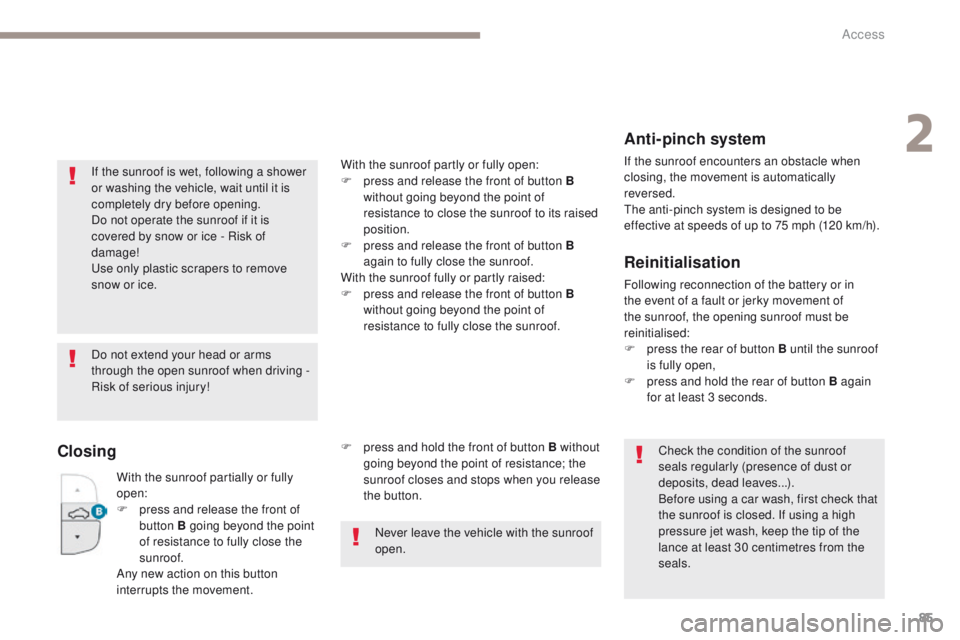
85
3008-2_en_Chap02_ouvertures_ed01-2016
If the sunroof is wet, following a shower
or washing the vehicle, wait until it is
completely dry before opening.
Do not operate the sunroof if it is
covered by snow or ice - Risk of
damage!
Use only plastic scrapers to remove
snow or ice.
Do not extend your head or arms
through the open sunroof when driving -
Risk of serious injury!
ClosingF press and hold the front of button B without going beyond the point of resistance; the
sunroof closes and stops when you release
the button.
Never leave the vehicle with the sunroof
open.
Anti-pinch system
If the sunroof encounters an obstacle when
closing, the movement is automatically
reversed.
The anti-pinch system is designed to be
effective at speeds of up to 75 mph (120 km/h).
Reinitialisation
Following reconnection of the battery or in
the event of a fault or jerky movement of
the sunroof, the opening sunroof must be
reinitialised:
F
p
ress the rear of button B until the sunroof
is fully open,
F
p
ress and hold the rear of button B again
for at least 3 seconds.
Check the condition of the sunroof
seals regularly (presence of dust or
deposits, dead leaves...).
Before using a car wash, first check that
the sunroof is closed. If using a high
pressure jet wash, keep the tip of the
lance at least 30 centimetres from the
seals.
With the sunroof partially or fully
open:
F
p
ress and release the front of
button B going beyond the point
of resistance to fully close the
sunroof.
Any new action on this button
interrupts the movement. With the sunroof partly or fully open:
F
p
ress and release the front of button
B
without going beyond the point of
resistance to close the sunroof to its raised
position.
F
p
ress and release the front of button B
again to fully close the sunroof.
With the sunroof fully or partly raised:
F
p
ress and release the front of button
B
without going beyond the point of
resistance to fully close the sunroof.
2
Access
Page 88 of 566

86
3008-2_en_Chap02_ouvertures_ed01-2016
Operating the sunroof blind
Opening
F Press and hold the rear of button A, without
going beyond the point of resistance; the
blind opens and stops when you release
the button. During simultaneous closing of the
sunroof and the blind, if the blind
catches up with the sunroof, the
blind then suspends its movement
and automatically resumes when the
sunroof stops.
The closing movement of the blind is limited by
the position of the opening sunroof: the blind
cannot be further for ward than the front of the
mobile glass.
Closing
Any new action on this button interrupts the
movement.
Anti-pinch system
If the blind encounters an obstacle when
closing, the movement is automatically
reversed.
Reinitialisation
Following reconnection of the battery or in the
event of a fault or jerky movement of the blind,
the blind must be reinitialised:
F
p
ress the rear of button A until the blind is
fully open,
F
p
ress and hold the rear of button A again
for at least 3 seconds.
F
P
ress the rear of button A going
beyond the point of resistance to
fully open the blind.
Any new action on this button interrupts the
movement. F
P
ress the front of button A ,
going beyond the point of
resistance to fully close the
blind.
F
P
ress and hold the front of button
A ,
without going beyond the point of
resistance; the blind closes and stops
when you release the button.
Access
Page 89 of 566
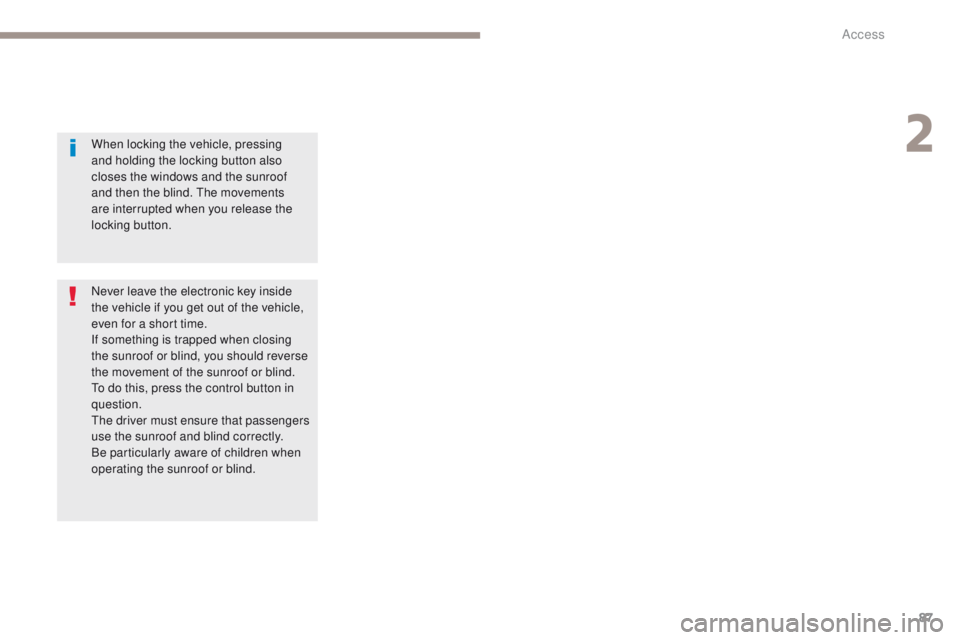
87
3008-2_en_Chap02_ouvertures_ed01-2016
When locking the vehicle, pressing
and holding the locking button also
closes the windows and the sunroof
and then the blind. The movements
are interrupted when you release the
locking button.
Never leave the electronic key inside
the vehicle if you get out of the vehicle,
even for a short time.
If something is trapped when closing
the sunroof or blind, you should reverse
the movement of the sunroof or blind.
To do this, press the control button in
question.
The driver must ensure that passengers
use the sunroof and blind correctly.
Be particularly aware of children when
operating the sunroof or blind.
2
Access
Page 90 of 566
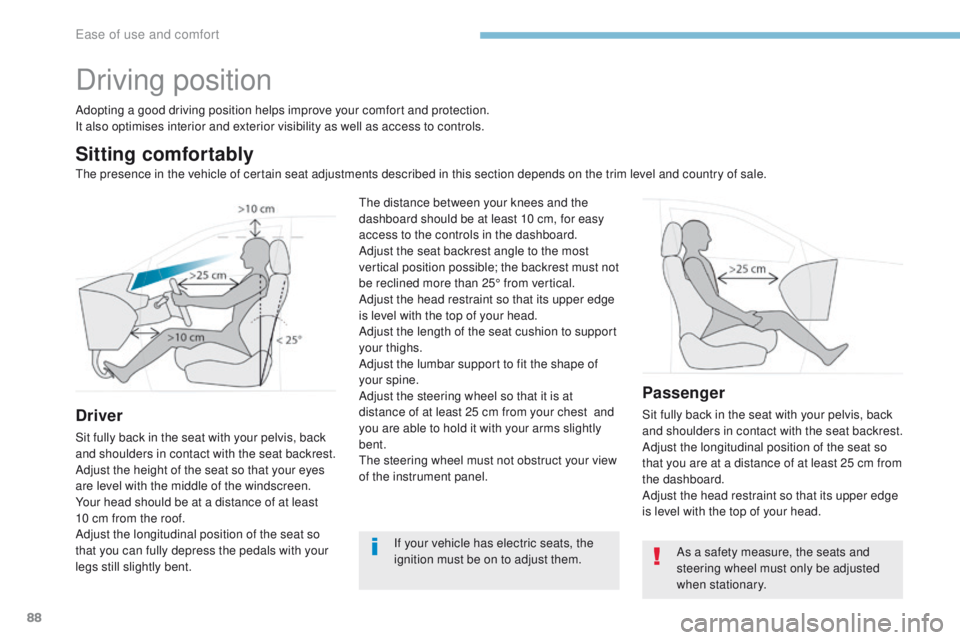
88
3008-2_en_Chap03_ergonomie-et-confort_ed01-2016
Driving position
Adopting a good driving position helps improve your comfort and protection.
It also optimises interior and exterior visibility as well as access to controls.
Sitting comfortably
Driver
Sit fully back in the seat with your pelvis, back
and shoulders in contact with the seat backrest.
Adjust the height of the seat so that your eyes
are level with the middle of the windscreen.
Your head should be at a distance of at least
10 cm from the roof.
Adjust the longitudinal position of the seat so
that you can fully depress the pedals with your
legs still slightly bent.
Passenger
Sit fully back in the seat with your pelvis, back
and shoulders in contact with the seat backrest.
Adjust the longitudinal position of the seat so
that you are at a distance of at least 25 cm from
the dashboard.
Adjust the head restraint so that its upper edge
is level with the top of your head.
If your vehicle has electric seats, the
ignition must be on to adjust them.
The distance between your knees and the
dashboard should be at least 10 cm, for easy
access to the controls in the dashboard.
Adjust the seat backrest angle to the most
vertical position possible; the backrest must not
be reclined more than 25° from vertical.
Adjust the head restraint so that its upper edge
is level with the top of your head.
Adjust the length of the seat cushion to support
your thighs.
Adjust the lumbar support to fit the shape of
your spine.
Adjust the steering wheel so that it is at
distance of at least 25 cm from your chest
and
you are able to hold it with your arms slightly
bent.
The steering wheel must not obstruct your view
of the instrument panel.
As a safety measure, the seats and
steering wheel must only be adjusted
when stationary.
The presence in the vehicle of certain seat adjustments described in this section depends on the trim level and country of sale.
Ease of use and comfort